Convertible AUDI A5 2015 Owner´s Manual
[x] Cancel search | Manufacturer: AUDI, Model Year: 2015, Model line: A5, Model: AUDI A5 2015Pages: 264, PDF Size: 66.83 MB
Page 127 of 264
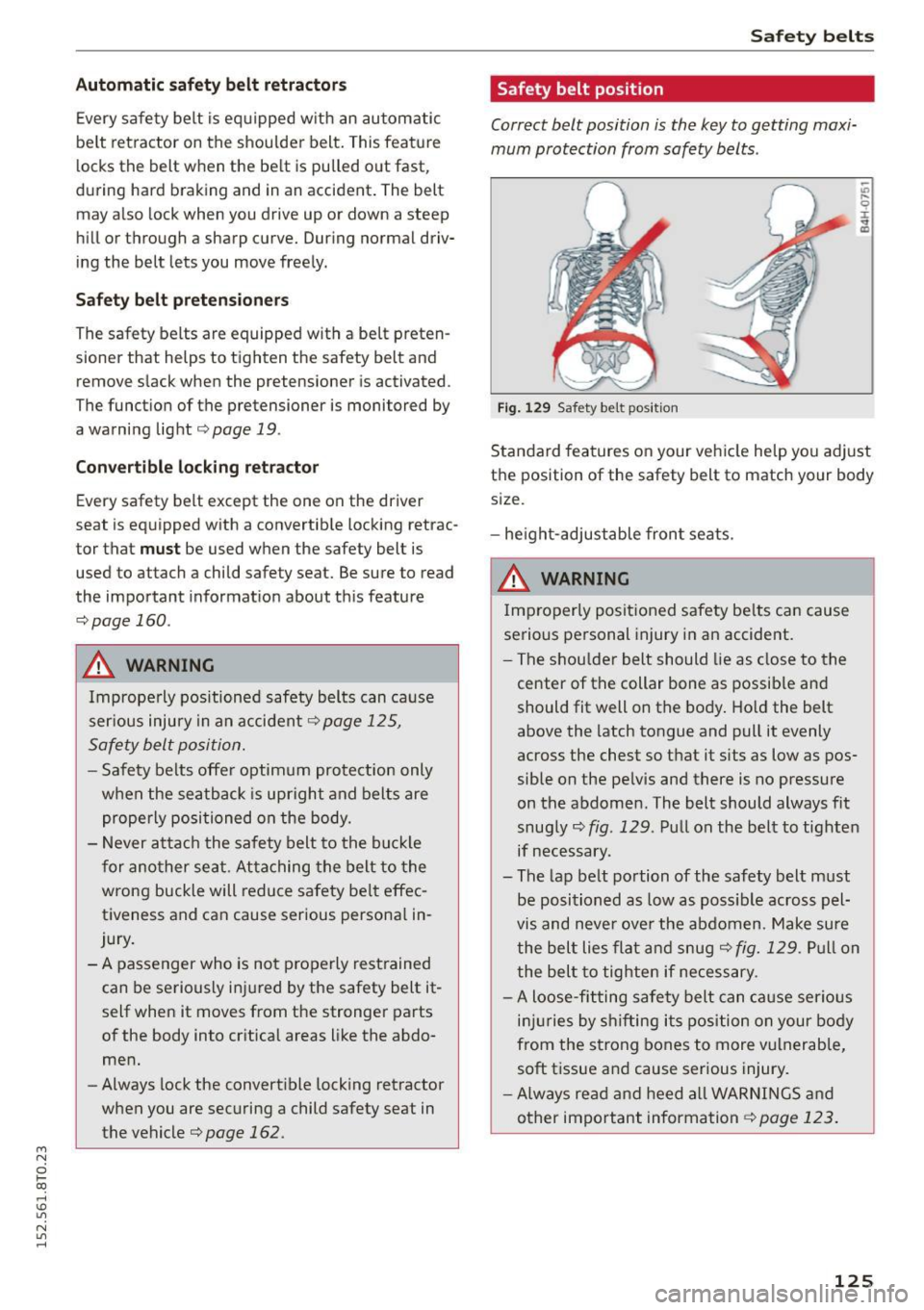
M N
0 loo
rl I.O
"' N
"' rl
Automatic safety belt retractors
Every safety belt is equipped with an automatic
belt retractor on the shoulder belt. This feature
locks the belt when the belt is pulled out fast,
during hard braking and in an accident . The belt
may also lo ck when you drive up or down a steep
hill or through a sharp curve. During normal driv
ing the belt lets you move freely.
Safety belt pretensioners
The safety belts are equipped with a belt preten
sioner that helps to tighten the safety belt and
remove slack when the pretensioner is activated.
The function of the pretensioner is monitored by
a warning light
r::> page 19.
Convertible locking retractor
Every safety belt except the one on the driver
seat is equipped with a convertible locking retrac
tor that
must be used when the safety belt is
used to attach a child safety seat. Be sure to read
the important information about this feature
r::;, page 160 .
& WARNING
Improperly positioned safety belts can cause
serious injury in an accident
r::;, page 125,
Safety belt position.
- Safety belts offer optimum protection only
when the seatback is upright and belts are
properly positioned on the body.
- Never attach the safety belt to the buckle
for another seat. Attaching the belt to the
wrong buckle will reduce safety belt effec
tiveness and can cause serious personal in
jury.
- A passenger who is not properly restrained
can be seriously injur ed by the safety belt it
self when it moves from the stronger parts of the body into critical areas like the abdo
men.
- Always lock the convertible locking retractor
when you are securing a child safety seat in
the vehicle
r::> page 162.
Safety belts
Safety belt position
Correct belt position is the key to getting maxi
mum protection from safety belts.
Fig. 129 Safety belt position
Standard features on your vehicle help you adjust
the position of the safety belt to match your body
size.
- height-adjustable front seats .
& WARNING
Improperly positioned safety belts can cause
serious personal injury in an accident.
- The shoulder belt should lie as close to the
center of the collar bone as possible and
should fit well on the body. Hold the belt
above the latch tongue and pull it evenly
across the chest so that it sits as low as pos
sible on the pelvis and there is no pressure
on the abdomen. The belt should always fit
snugly
r::;, fig . 129 . Pull on the belt to tighten
if necessary.
- The lap belt portion of the safety belt must
be positioned as low as possible across pel
vis and never over the abdomen. Make sure
the belt lies flat and snug
r::> fig. 129. Pull on
the belt to tighten if necessary.
- A loose-fitting safety belt can cause serious
injuries by shifting its position on your body
from the strong bones to more vulnerable,
soft tissue and cause serious injury.
-Always read and heed all WARNINGS and
other important information
r::;, page 123.
125
Page 142 of 264
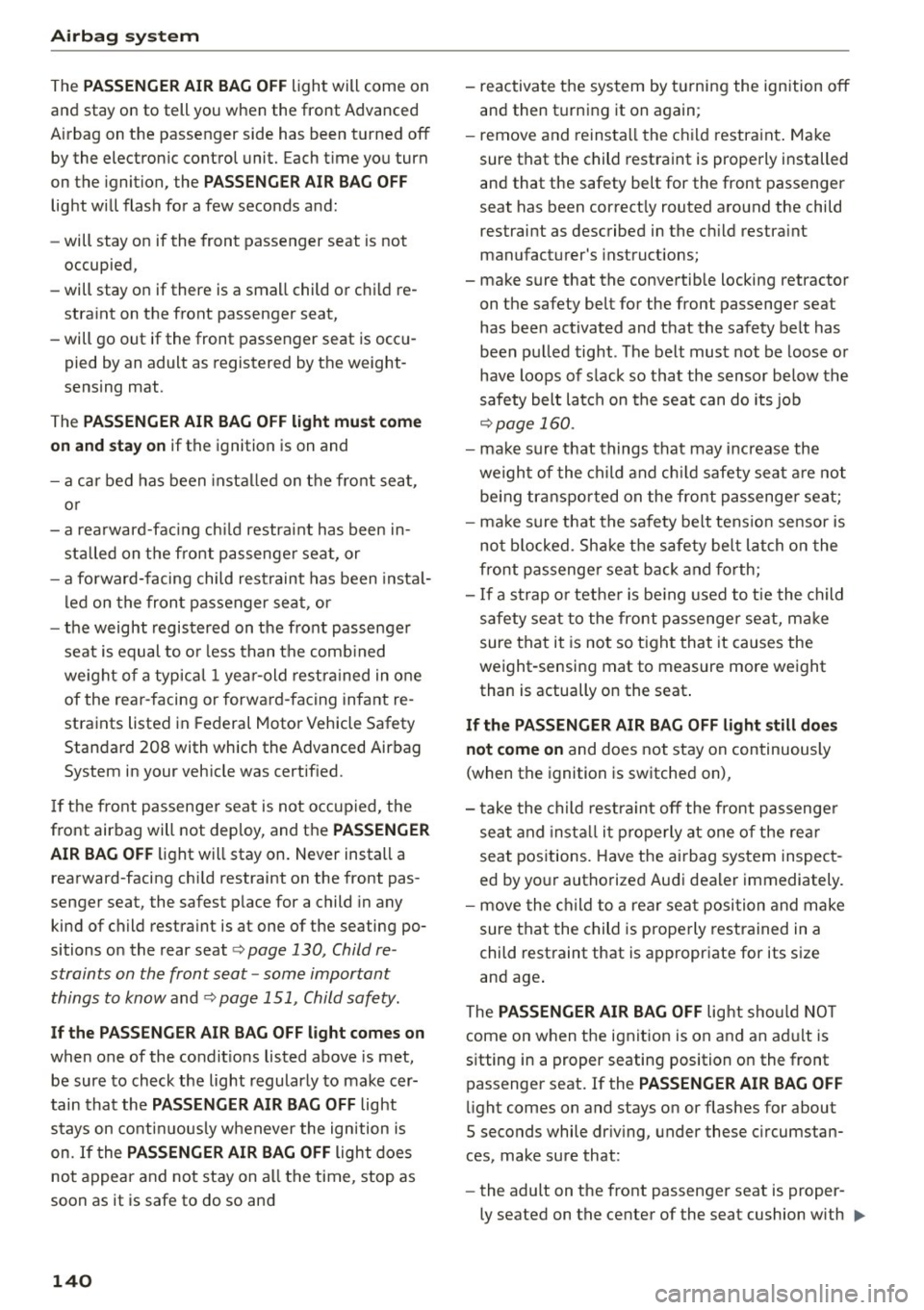
Airbag system
The PASSENGER AIR BAG OFF light will come on
and stay on to tell you when the front Advanced
Airbag on the passenger side has been t urned off
by the electron ic control unit. Each time you turn
on the ignition, the
PASSENGER AIR BAG OFF
light will flash for a few seconds and:
- will stay on if the front passenger seat is not
occupied,
- will stay on if there is a small child or child re
straint on the front passenger seat,
- will go out if the front passenger seat is occu
pied by an adult as registered by the weight
sensing mat .
The
PASSENGER AIR BAG OFF light must come
on and stay on
if the ignition is on and
- a car bed has been installed on the front seat ,
or
- a rearward-fac ing ch ild restra int has been in
stalled on the front passenger seat, or
- a fo rward-facing child restraint has been instal
led on the front passenger seat, or
- the weight registered on the front passenger
seat is equal to or less than the comb ined
weight of a typical 1 year-old restrained in one
of the rear-facing or forwa rd-facing infant re
straints listed in Federal Motor Vehicle Safety
Standard 208 with which the Advanced Airbag
System in your vehicle was certified .
If the front passenger seat is not occupied, the
front airbag will not deploy, and the
PASSENGER
AIR BAG OFF
light will stay on. Never install a
rearward -facing chi ld restraint on the front pas
senger seat, the safest place for a child in any
kind of child restraint is at one of the seating po
sitions on the rear seat
c> page 130, Child re
straints on the front seat -some important
things to know
and c> page 151, Child safety.
If the PASSENGER AIR BAG OFF light comes on
when one of the condit ions listed above is met,
be sure to check the light regularly to make cer
tain that the
PASSENGER AIR BAG OFF light
stays on continuously whenever the ignition is
on.
If the PASSENGER AIR BAG OFF light does
not appear and not stay on all the time, stop as
soon as it is safe to do so and
140
- reactivate the system by turning the ignition off
and then turning it on again ;
- remove and reinstall the child restraint. Make
sure that the child restraint is properly installed
and that the safety belt for the front passenger
seat has been co rrectly routed around the child
restraint as described in the ch ild restra int
manufacturer's instructions;
- make sure that the convertible locking retractor
on the safety belt for the front passenger seat
has been activated and that the safety belt has
been pulled tight. The belt must not be loose or
have loops of s lack so that the sensor below the
safety belt latch on the seat can do its job
<=>page 160.
-make sure that things that may increase the
we ight of the child and child safety seat are not
being transported on the front passenger seat;
- make sure that the safety belt tension sensor is
not blocked. Shake the safety belt latch on the
front passenger seat back and forth;
- If a strap or tethe r is be ing used to tie the child
safety seat to the front passenger seat, make
sure that it is not so tight that it causes the
weight-sensing mat to measure more weight than is actually on the seat.
If the PASSENGER AIR BAG OFF light still does
not come on
and does not stay on continuously
(when the ignition is switched on),
- take the child restra int off the front passenger
seat and install it p roperly at one of the rear
seat positions. Have the airbag system inspect
ed by yo ur authorized Audi dealer immediately.
- move the child to a rear seat position and make
sure that the child is properly restrained in a
child restraint that is appropr iate for its size
and age .
The
PASSENGER AIR BAG OFF light sho uld NOT
come on when the ignit ion is on and an ad ult is
sitting in a proper seating position on the front
passenger seat. If the
PASSENGER AIR BAG OFF
light comes on and stays on or flashes for about
5 seconds while dr iv ing, under these c ircumstan
ces, make sure that:
- the adult on the front passenger seat is proper-
ly seated on the center of the seat cushion with ..,.
Page 155 of 264
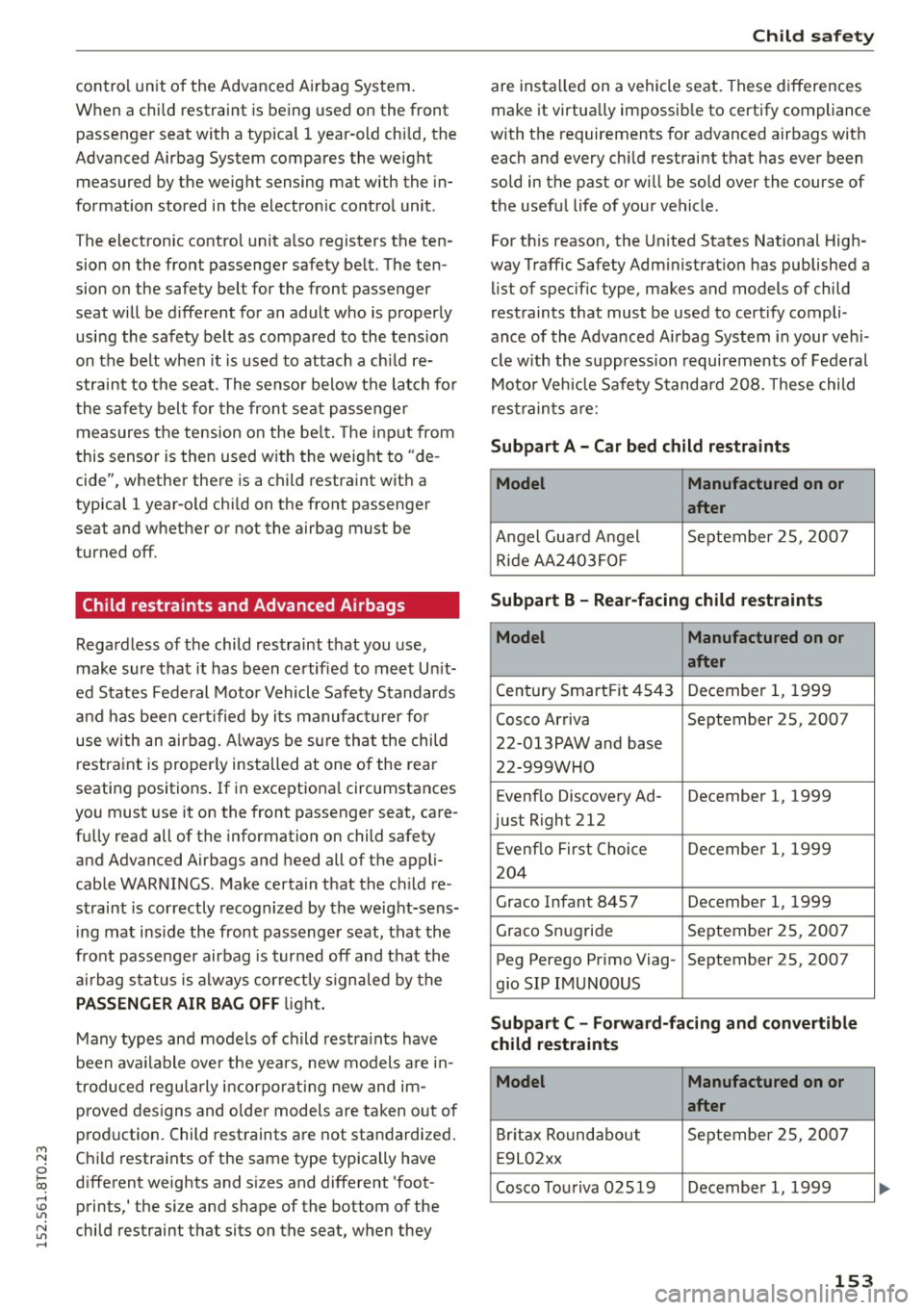
M N
i? co ,...., \!) Ll'I
N Ll'I ,....,
control unit of the Advanced Airbag System .
When a child restraint is being used on the front passenger seat with a typical 1 year -o ld chi ld, the
Advanced Airbag System compares the weight measured by the weight sensing mat with the in
formation stored in the electron ic contro l unit .
T he electronic control unit a lso registers the ten
sion on the front passenger safety belt. The ten
sion on the safety belt for the front passenger
seat will be different for an adult who is properly
usi ng the safety belt as compared to the tens ion
on the belt w hen it is used to attach a chi ld re
straint to the sea t. The senso r below the latch fo r
the safe ty belt for the fron t seat passenger
measures the tension on the be lt. The inp ut from
this sensor is then used with the weight to "de
cide", whether the re is a child restraint wit h a
typical 1 year-old chi ld on the front passenger
seat and whether or not the airbag must be
turned
off .
Child restraints and Advanced Airbags
Regardless of the chi ld restraint that you use,
make sure that it has been ce rtified to meet Un it
ed States Fede ral Motor Vehicle Safety Standards
and has been certified by i ts manufac turer for
use w ith an airbag . A lways be sure tha t the child
restra int is properly installed at one o f the rear
seating positions . If in exceptiona l circumstances
you must use it on the front passenger seat, care fu lly read all of the information on child safety
and Advanced Airbags and heed all of the appli
cable WARNINGS . Make certain that the ch ild re
straint is correctly recognized by the weight-sens
i ng mat i nside the front passenge r seat, that the
fr ont passenger airbag is tu rned
off and that the
air bag status is always corre ct ly signaled by the
PASSENGER AIR BAG OFF li ght .
Many types and models of ch ild rest ra ints have
b een ava ilable over the yea rs, new models are i n
t roduced regul arly incorpo rat ing new and im
p roved des igns and o lder models a re taken o ut o f
p ro du ction. Child rest raints a re not standardized.
Child restra ints of the same type typically have
d ifferent weights and s iz es and different 'foot
prin ts,' the si ze and shape of the bottom of the
child restraint that sits on the seat , when they
Child sa fety
are insta lled on a vehicle seat. These differences
make it virtua lly impossib le to certify compliance
with t he requirements for advanced airbags with
each and every chi ld restraint that has ever been
sold in the past or will be sold over the course of
the usefu l life of your vehicle.
For t his reason, the United States National High
way Traffic Safety Adm inistrat ion has published a
li st of spec ific type, makes and models of child
restraints that must be used to cert ify compli
ance of the Advanced Airbag System in your ve hi
cle w ith the s uppression r equirements of Federal
Motor Veh icle Safety S tanda rd 208. These child
rest rain ts a re:
Subpart A -Car bed child restraints
Model Manufactured on or
after
A ngel Gua rd A ngel September 2S , 200 7
R ide AA2403FOF
Subpart B -Rear-facing child restraints
Model Manufactured on or
after
Century Smart Fit 4543 Decembe r 1, 1999
Cosco Ar riva September 25, 2007
22-013PAW and base
22-999WHO
E venflo Discovery Ad -December 1, 1999
just Right 212
E venflo First Choi ce De cembe r 1, 1999
204
Graco Infant 8457 Decembe r 1, 1999
Graco Sn ug ride September 25, 200
7
Peg Perego Pr imo Viag- September 2S, 2007
g io SIP IMUNOOUS
Subpart C -Forward-facing and convertible
child restraints
Model Manufactured on or
after
B rit a x Roundabout September 2S, 200 7
E 9L02xx
Cosco To uriva 02519 December 1, 1999
153
Page 158 of 264
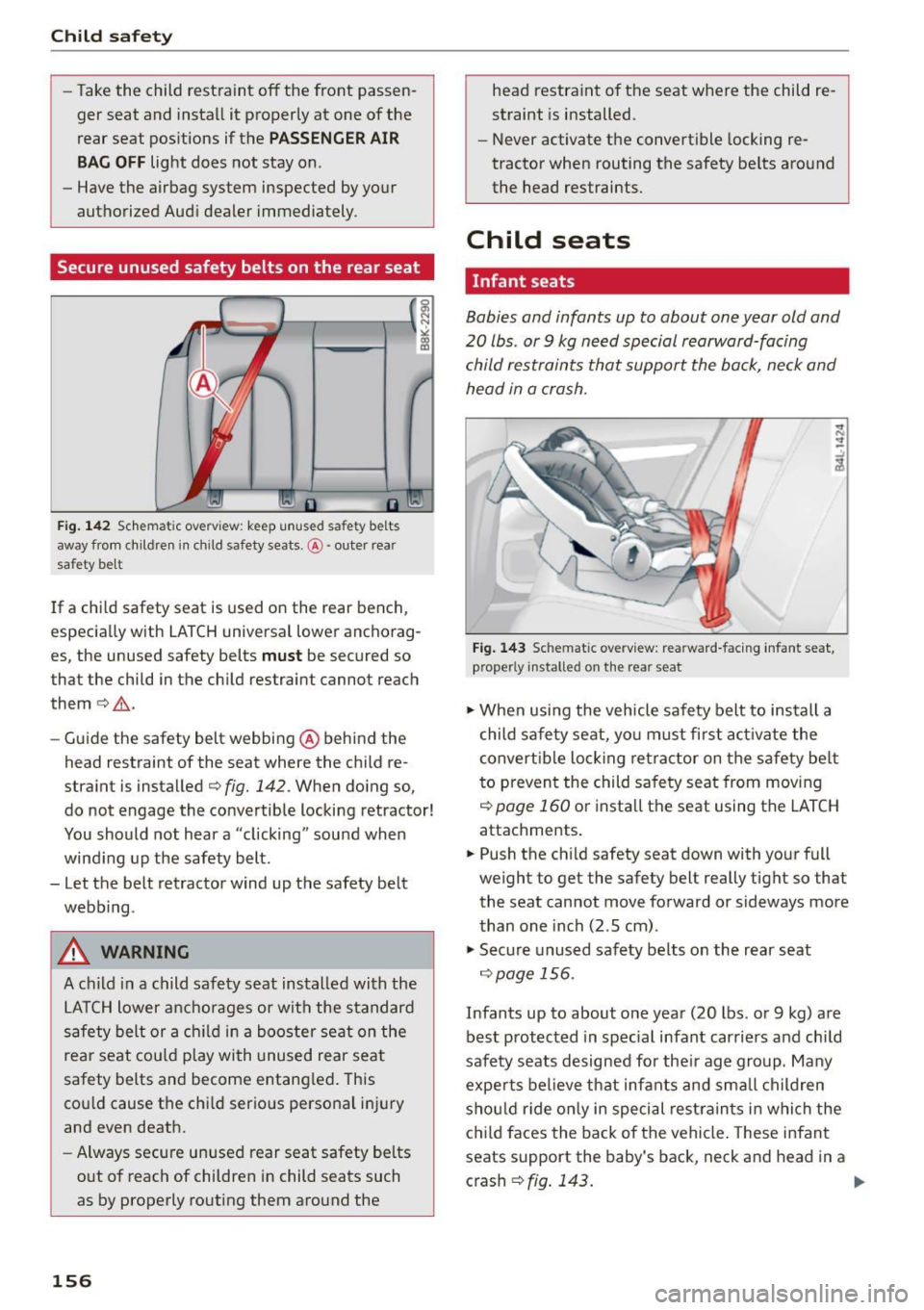
Child safety
-Take the child restraint off the front passen
ger seat and install it properly at one of the
rear seat positions if the
PASSENGER AIR
BAG OFF
light does not stay on .
- Have the airbag system inspected by your
authorized Audi dealer immediately .
Secure unused safety belts on the rear seat
Fig. 142 Schemat ic overview : keep unus ed sa fety belt s
away from chil dren in chil d safety seats .@ · outer rea r
sa fety belt
If a child safety seat is used on the rear bench,
especially with LATCH universal lower anchorag
es, the unused safety belts
must be secured so
that the child in the child restraint cannot reach
them ¢,& .
- Guide the safety belt webbing @ behind the
head restraint of the seat where the child re
straint is installed
¢fig. 142. When doing so,
do not engage the convertible locking retractor!
You should not hear a "clicking" sound when
winding up the safety belt .
- Let the belt retractor wind up the safety belt webbing .
.,&. WARNING
A child in a child safety seat installed with the
LATCH lower anchorages or with the standard
safety belt or a child in a booster seat on the
rear seat could play with unused rear seat
safety belts and become entangled. This
could cause the child serious personal injury
and even death.
- Always secure unused rear seat safety belts
out of reach of children in child seats such
as by properly routing them around the
156
head restraint of the seat where the child re
straint is installed.
- Never activate the convertible locking re
tractor when routing the safety belts around
the head restraints.
Child seats
Infant seats
Babies and infants up to about one year old and
20 lbs . or
9 kg need special rearward-facing
child restraints that support the back, neck and
head in a crash.
Fig. 143 Sc hem atic ove rview: rearward-facing infant seat,
prope rly installe d on the rea r seat
.,. When using the vehicle safety belt to install a
child safety seat, you must first activate the
convertible locking retractor on the safety belt
to prevent the child safety seat from moving
¢
page 160 or install the seat using the LATCH
attachments.
.,. Push the child safety seat down with your full
weight to get the safety belt really tight so that
the seat cannot move forward or sideways more than one inch (2.5 cm) .
.,. Secure unused safety belts on the rear seat
¢page 156.
Infants up to about one year (20 lbs. or 9 kg) are
best protected in special infant carriers and child
safety seats designed for their age group. Many experts believe that infants and small children
should ride only in special restraints in which the
child faces the back of the vehicle. These infant
seats support the baby's back, neck and head in a
crash
¢ fig. 143. .,.
Page 159 of 264
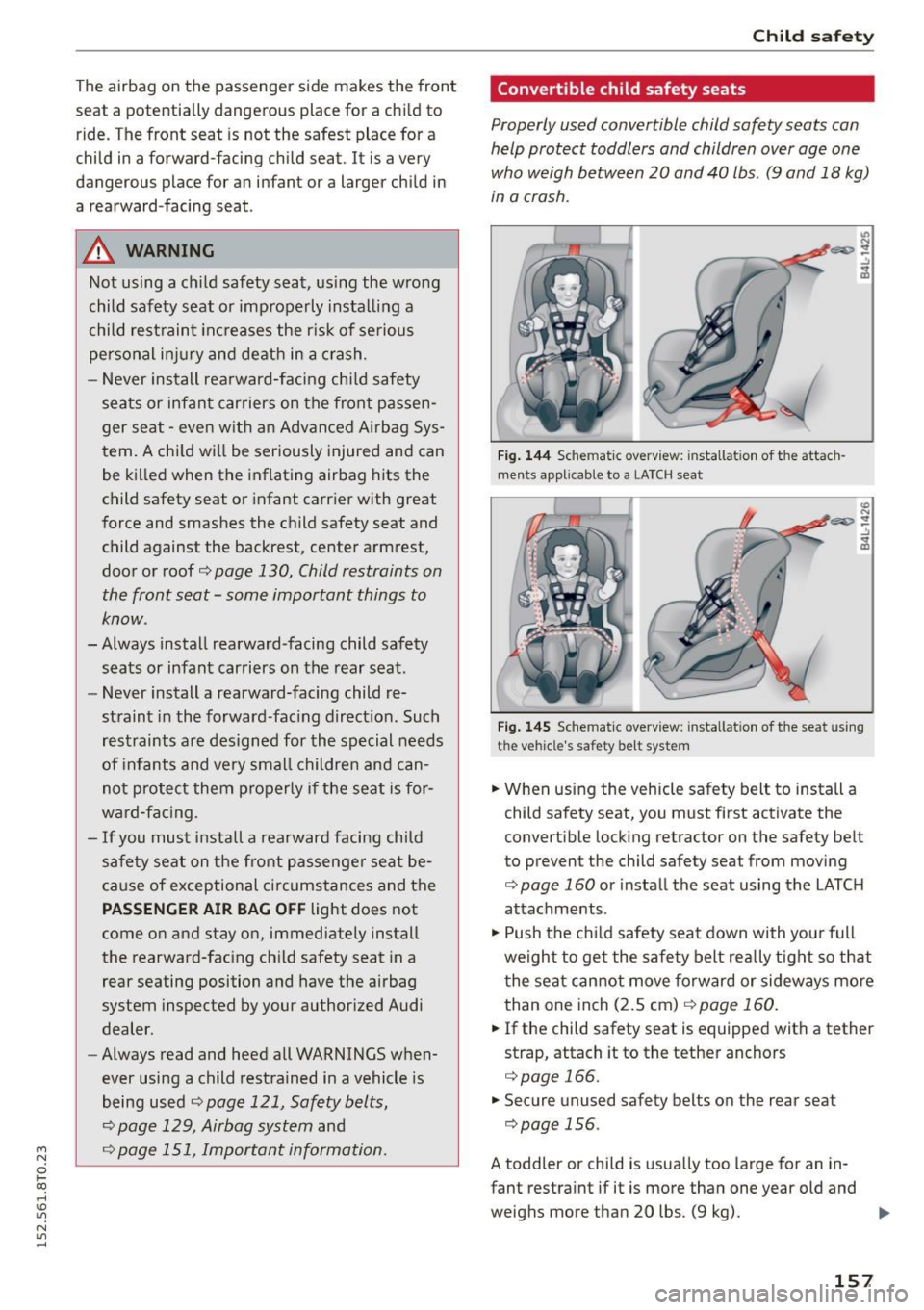
M N
0 loo
rl I.O
"' N
"' rl
The airbag on the passenger side makes the front
seat a potentially dangerous place for a chi ld to
ride . The front seat is not the safest place for a
chi ld in a forward-facing child seat. It is a very
dangerous place for an infant or a large r child in
a rearward -facing seat .
& WARNING
Not using a ch ild safety seat, using the w rong
child saf ety seat or improperly installing a
child rest raint in cr eases the r is k of serious
pe rsonal in jury and death in a crash.
- Never install rea rward-faci ng ch ild safety
seats or infant car riers on the front passe n
ger seat -even wit h an Adv anced A irbag Sys
tem . A child w ill be seriously injured and can
be k illed when the inflat ing airbag hits the
child safety seat or infant carr ier with great
force and smashes the child safety seat and
child against the backrest, center armrest,
door or roof¢
page 130, Child restraints on
the front seat -some important things to
know .
- Always install rearward -facing child safety
seats or infant car riers on the rear seat .
- Never install a rearward-facing child re
straint in the forward -fac ing direct ion . Such
rest raints a re des igned for the special needs
of infants and very sma ll childre n and can
not p rotect them p roperly if the seat is fo r
w ard-fac ing .
-If you must install a rea rward faci ng chi ld
s afety sea t on t he front passenger sea t be
ca use of exceptional ci rcumstances and the
PASSENGER AIR BAG OFF light does not
come on and stay on, immediately install
the rearward-fac ing ch ild safety seat in a
rear seating position and have the airbag
system inspected by your author ized Audi
dealer .
- Always read and heed all WARNINGS w hen
ever using a child restra ined in a vehicle is
being used¢
page 121, Safety belts,
¢ page 129, Airbag system and
¢ page 151, Important information.
Child sa fe ty
Convertible child safety seats
Properly used convertible child safety seats con
help protect toddlers and children over age one who weigh between 20 and 40 lbs. (9 and 18 kg)
in a crash.
F ig . 144 Sc hemat ic ove rv iew: installat io n of t he attach
me nts applicable to a LATCH seat
F ig . 14 S Schemat ic ove rv iew: insta llat io n of th e sea t usi ng
t he ve hicle's sa fety be lt system
.,. W hen us ing the vehicle safety belt to install a
child safety seat, you must first activate the
convert ible lock ing retractor on the safety be lt
t o prevent the child safety seat from mov ing
¢
page 160 or insta ll the seat using the LATC H
attachments .
.,. Push the ch ild safety seat down with you r full
we ight to ge t the safety belt re ally tigh t so that
t he seat can not move forward or sideways mo re
than one inch (2.5 cm)¢
page 160.
.,. If the child safety seat is equ ipped with a tether
strap, attach it to the tether anchors
¢ page 166.
.,. Secure unused safety belts on the rear seat
¢page 156.
A todd ler or child is usua lly too large for an in
fant restraint if it is more than one year old and
weighs more than 20 lbs. (9 kg).
IIJ,,,
157
Page 161 of 264
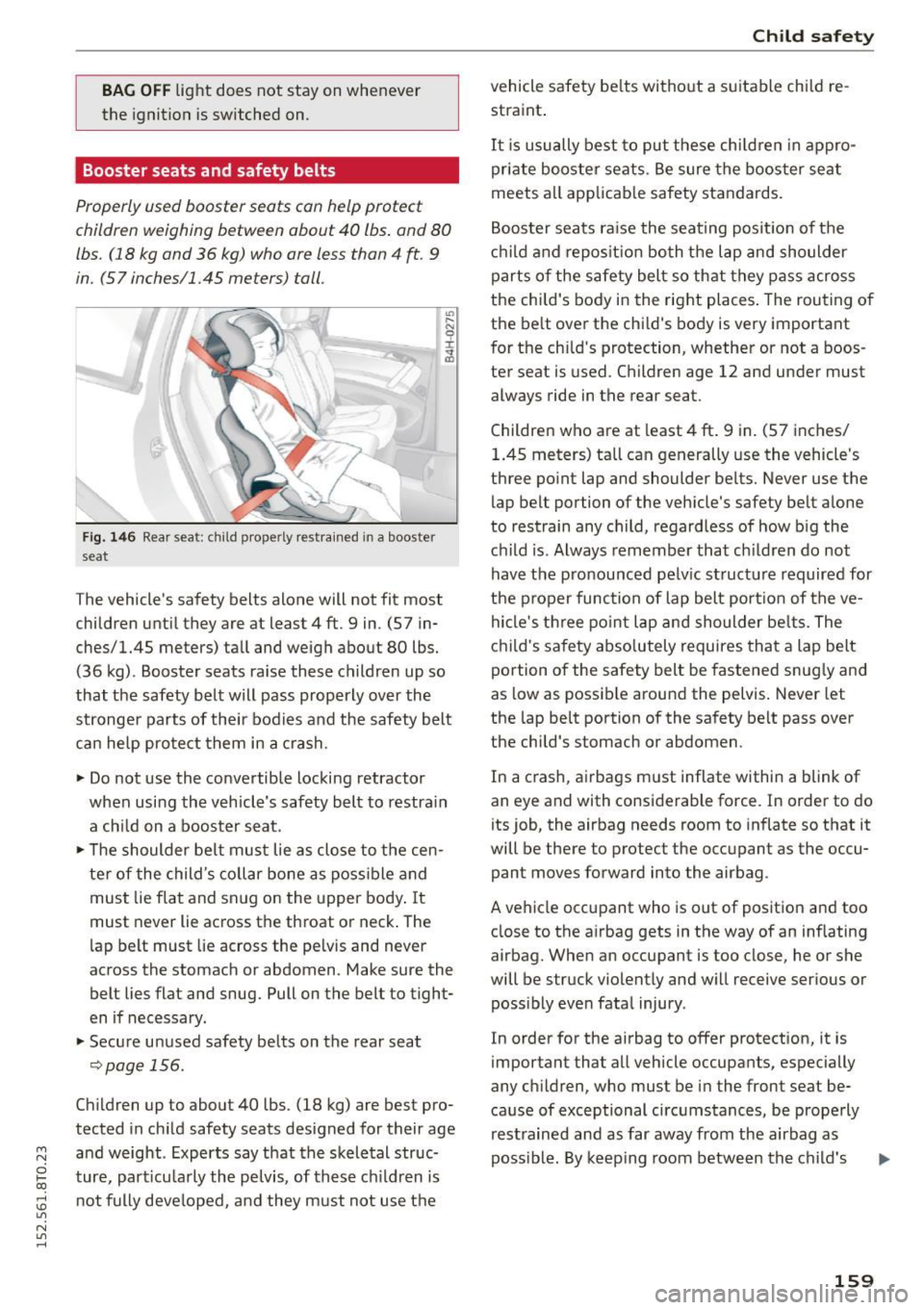
M N
0 loo
rl I.O
"' N
"' rl
BAG OFF light does not stay on whenever
the ignition is switched on.
Booster seats and safety belts
Properly used booster seats can help protect
children weighing between about 40 lbs . and 80
lbs. (18 kg and 36 kg) who are less than 4 ft .
9
in. (57 inches/1.45 meters) tall.
Fig. 1 46 Rea r seat : child p roper ly rest ra ined in a booster
seat
The vehicle's safety belts alone will not fit most
children until they are at least4
ft. 9 in . (57 in
ches/1.45 meters) tall and weigh about 80 lbs.
(36 kg). Booster seats raise these children up so
that the safety belt will pass properly over the
stronger parts of their bodies and the safety belt
can he lp protect them in a crash.
.,.. Do not use the convertible locking retractor
when using the vehicle's safety belt to restra in
a ch ild on a booster seat .
.,.. The shoulder be lt must lie as close to the cen
ter of the child's collar bone as poss ible and
must lie flat and snug on the upper body .
It
must never lie across the throat or neck. The
l ap belt must lie across the pe lvis and never
across the stomach or abdomen . Make sure the
belt lies flat and snug. Pull on the belt to tight
en if necessary.
.,.. Secure unused safety belts on the rear seat
<=> page 156.
Children up to about 40 lbs. (18 kg) are best pro
tected in ch ild safety seats des igned for their age
and weight . Experts say that the skeletal struc
ture, part icu larly the pe lvis, of these ch ildren is
n ot fully deve loped, and they m ust not use t he
Chil d sa fe ty
vehicle safety be lts without a suitable chi ld re
straint .
It is usually best to put these chi ldren in appro
priate booster seats. Be sure the booster sea t
meets a ll applicab le safety standards.
Booster seats ra ise the seating posit ion of the
c h ild and re pos it ion bo th the lap and shoulder
parts of the safety belt so that they pass across
the child's body in the right places . The routing of
the be lt over the child 's body is very important
for the ch ild's protection, whether or not a boos
ter seat is used. Children age 12 and under must
always ride in the rear seat.
Children who are at least 4
ft . 9 in. (57 inches/
1.45 meters) tall can generally use the vehicle's
three po int lap and shoulder be lts. Never use the
lap belt portion of the vehicle's safety belt a lone
to restrain any child, regardless of how big the
c hi ld is. Always remember that ch ildren do not
have the pronounced pe lv ic st ructu re required for
the proper func tion of lap belt port io n of the ve
hicle 's th ree po int l ap and shoulder be lts. The
ch ild 's sa fety abso lutely requires that a lap belt
portion of the safety belt be fastened snug ly and
as low as possib le around the pelvis . Never let
the lap belt portion of the safety belt pass over
the child's stomach or abdomen.
In a crash, airbags must inflate within a blink of
an eye and with considerable force. In order to do
its job, the airbag needs room to inflate so that it
will be there to protect the occupant as the occu
pant moves forward into the airbag .
A vehicle occ upant who is out of position and too
close to the a irbag gets in the way of an inflating
airbag. When an occupant is too close, he or she
will be struck violently and w ill receive serious or
poss ibly even fata l injury .
In order for the airbag to offer protection, it is
important that all vehicle occupants, especially
any children, who must be in the front seat be
cause of exceptional circumstances, be properly
rest rained and as far away from the airbag as
poss ible. By keep ing room between th e ch ild's
II>-
159
Page 162 of 264
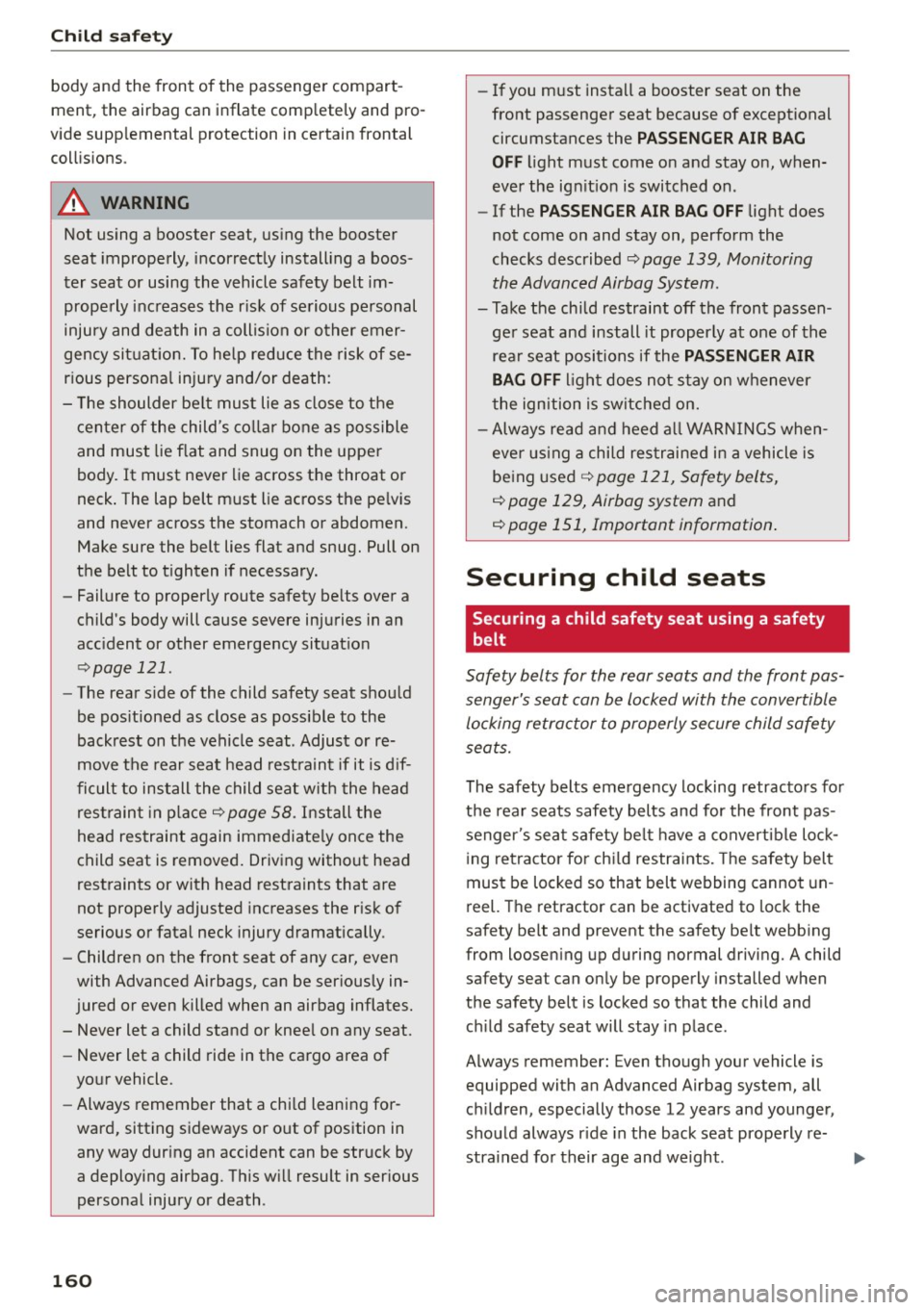
Child safety
body and the front of the passenger compart
ment, the airbag can inflate completely and pro
vide supplemental protection in certain frontal
collisions .
.,&. WARNING
Not using a booster seat, using the booster
seat improperly, incorrectly installing a boos
ter seat or using the vehicle safety belt im
properly increases the risk of serious personal
injury and death in a collision or other emer
gency situation. To help reduce the risk of se
rious personal injury and/or death:
- The shoulder belt must lie as close to the
center of the child's collar bone as possible
and must lie flat and snug on the upper
body. It must never lie across the throat or
neck. The lap belt must lie across the pelvis
and never across the stomach or abdomen.
Make sure the belt lies flat and snug. Pull on
the belt to tighten if necessary.
- Failure to properly route safety belts over a
child's body will cause severe injuries in an
accident or other emergency situation
c::> page 121 .
-The rear side of the child safety seat should
be positioned as close as possible to the
backrest on the vehicle seat . Adjust or re
move the rear seat head restraint if it is dif
ficult to install the child seat with the head
restraint in place
c::>page 58. Install the
head restraint again immediately once the
child seat is removed. Driving without head
restraints or with head restraints that are
not properly adjusted increases the risk of
serious or fatal neck injury dramatically .
- Children on the front seat of any car, even
with Advanced Airbags, can be seriously in
jured or even killed when an airbag inflates.
- Never let a child stand or kneel on any seat.
- Never let a child ride in the cargo area of
your vehicle.
- Always remember that a child leaning for
ward, sitting sideways or out of position in
any way during an accident can be struck by
a deploying airbag. This will result in serious
personal injury or death .
160
-If you must install a booster seat on the
front passenger seat because of exceptional
circumstances the
PASSENGER AIR BAG
OFF
light must come on and stay on, when
ever the ignition is switched on .
- If the
PASSENGER AIR BAG OFF light does
not come on and stay on, perform the
checks described
c::, page 139, Monitoring
the Advanced Airbag System.
- Take the child restraint off the front passen
ger seat and install it properly at one of the rear seat positions if the
PASSENGER AIR
BAG OFF
light does not stay on whenever
the ignition is switched on.
- Always read and heed all WARNINGS when
ever using a child restrained in a vehicle is
being used
<=> page 121, Safety belts,
<=>page 129, Airbag system
and
c::> page 151, Important information.
Securing child seats
' Securing a child safety seat using a safety
I _!>elt
Safety belts for the rear seats and the front pas
senger's seat con be locked with the convertible
locking retractor to properly secure child safety
seats.
The safety belts emergency locking retractors for
the rear seats safety belts and for the front pas
senger's seat safety belt have a convertible lock
ing retractor for child restraints. The safety belt
must be locked so that belt webbing cannot un
reel. The retractor can be activated to lock the
safety belt and prevent the safety belt webbing
from loosening up during normal driving. A child
safety seat can only be properly installed when
the safety belt is locked so that the child and child safety seat will stay in place.
Always remember: Even though your vehicle is equipped with an Advanced Airbag system, all
children, especially those 12 years and younger,
should always ride in the back seat properly re-
strained for their age and weight . ..,_
Page 164 of 264
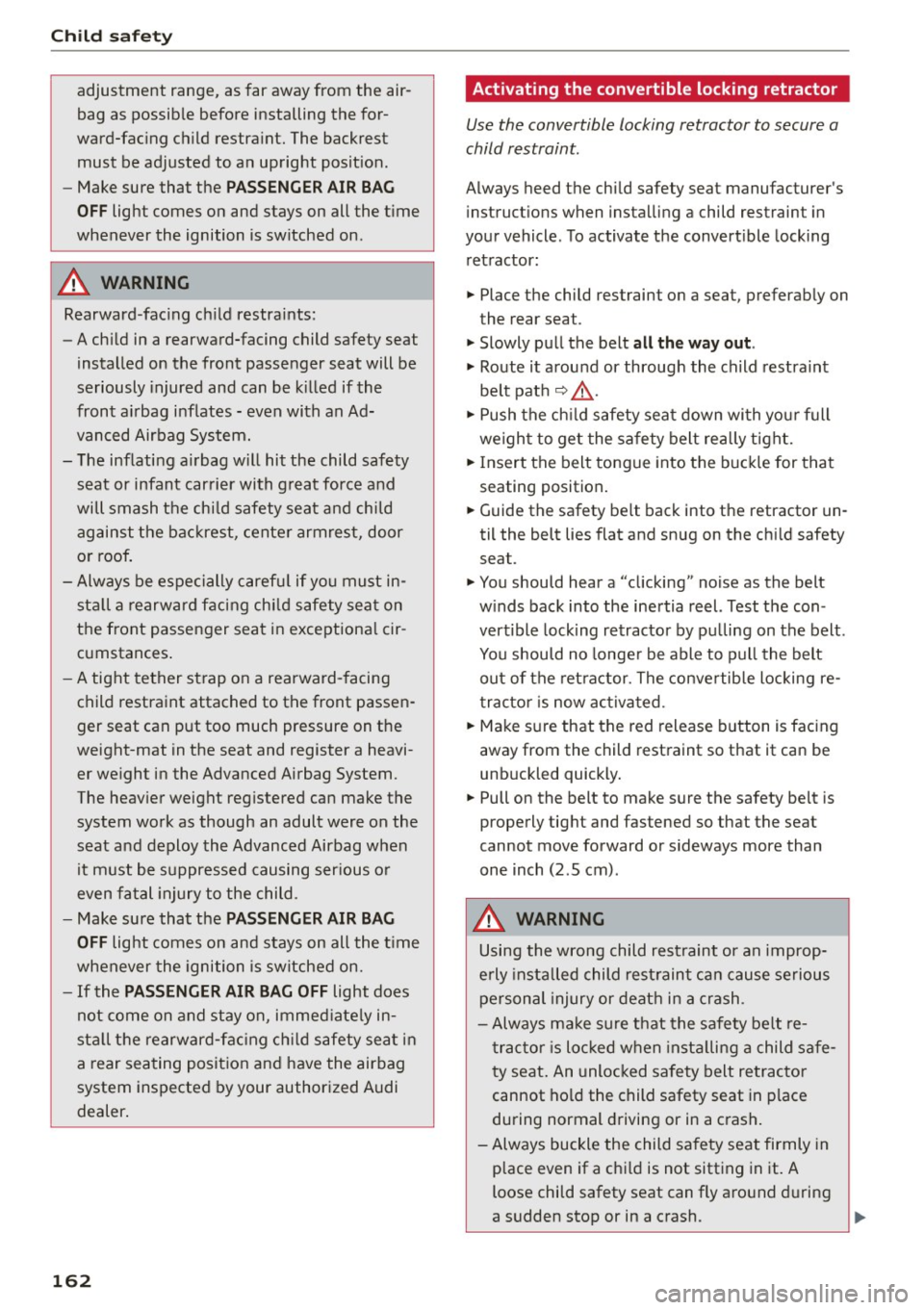
Child safet y
adjustment range, as far away from the air
bag as possib le before installing the for
ward-fac ing ch ild restraint. The backrest
must be adjusted to an upright posit ion.
- Make sure that the
PASSENGER AIR BAG
OFF
light comes on and stays on all the t ime
whenever the ignition is switched on.
A WARNING
Rearward-fac ing ch ild restra ints:
- A ch ild in a rearward-facing child safety seat
installed on the front passenger seat will be
seriously injured and can be k illed if the
front a irbag inflates - even with an Ad
vanced Airbag System.
- The inflating a irbag w ill hit the child safety
seat or infant car rier with great force and
will smash the chi ld safety seat and child
against the bac krest, center armrest, door
or roof .
- Always be espe cially caref ul if you must in
sta ll a rearward facing chi ld safety seat on
the front passenger seat in exceptiona l cir
cumstances .
- A tight tether strap on a rearward-facing
child restraint attached to the front passen
ger seat can put too much pressure on the
weight-mat in the seat and register a heavi er we ight in the Advanced Airbag System.
The heav ier weight reg istered can make the
system work as though an adult were on the
seat and deploy the Advanced Airbag when it m ust be s uppressed causing ser ious o r
even fatal injury to the child.
- Make sure that the
PASSENGER AIR BAG
OFF
light comes on and s tays on all the t ime
whenever the ignition is switched on.
- If the PASSENGER AIR BAG OFF light does
not come on and stay on, immed iate ly in
sta ll the rearward-fac ing ch ild safety sea t in
a rear seating posit ion and have the airbag
system inspected by your authorized Audi
dealer .
162
· Activating the convertible locking retractor
Use the convertible locking retractor to secure a
child restraint.
Always heed the child safety seat manufacturer's
i nstruct ions when installing a child restraint in
your vehicle . T o activate the convert ible locking
retractor:
.. Place the child restraint on a seat, preferably on
the rear seat .
.. Slowly pull the belt
all th e wa y out .
.. Route it around or through the child restraint
belt pat h
c::> _&..
.. Push the ch ild safety seat down with your full
weigh t to get the sa fety belt really tight.
.. Insert the belt tongue into the b uckle for that
seating position .
.. Guide the safety be lt back into the retractor un
til the belt lies flat and snug on the ch ild safety
seat.
.. You should hear a "clicking" noise as the belt
w inds back into the inertia reel. Test the con
vert ible lock ing retractor by pu lling on the belt .
You should no longer be able to pull the belt
out of the ret ractor. The conve rtible locking re
tractor is now ac tivated .
.. Make s ure that the red release button is fac ing
away from the child restraint so that it can be
unbuckled quickly .
.. Pull on the belt to make sure the safety be lt is
properly tight and fastened so that the seat
cannot move forward or s ideways more than
one inch (2 .5 cm).
A WARNING
Using the wrong child restraint or an improp
e rly installed child restraint can cause serious
personal injury or death in a crash.
- Always ma ke sure that the safe ty be lt re
tracto r is loc ked when insta lling a child sa fe
ty seat. An unlocked sa fety belt retractor
cannot ho ld the child safety seat in place
during normal driving or in a crash.
- Always buckle the child safety seat firmly in place even if a chi ld is not sitting in it. A
loose child safety seat can fly around d uring
a sudden stop or in a crash.
.
Page 165 of 264
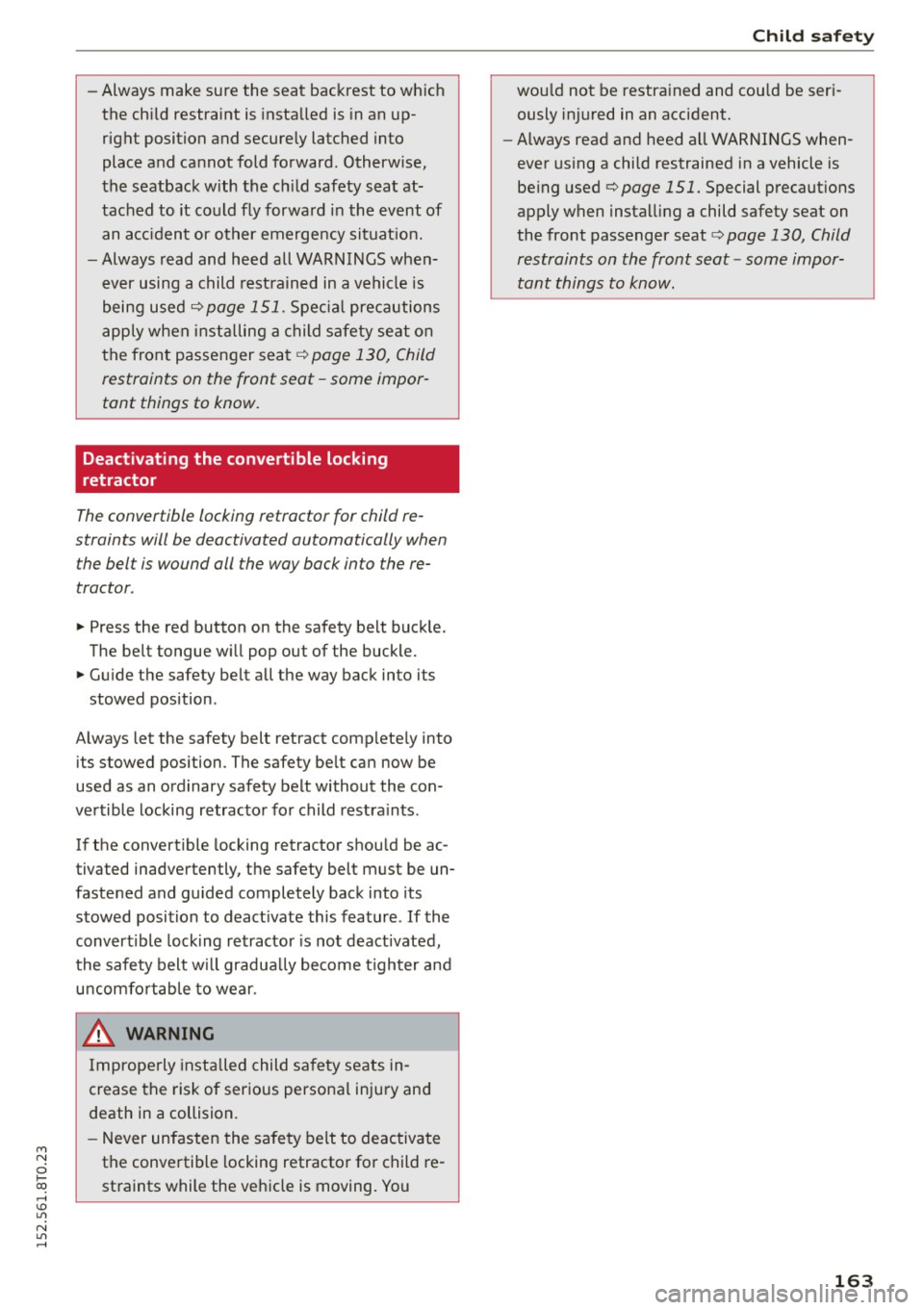
M N
i? co ,...., \!) 1.1'1
N 1.1'1 ,....,
-Always make sure the seat backrest to which
the ch ild restraint is installed is in an up
right position and securely latched into
place and cannot fold forward. Otherw ise,
the seatback with the ch ild safety seat at
tached to it co uld f ly forward in the event of
an acc ident or o ther emergency si tuat ion.
- Always read and heed all WARNINGS when
ever using a child rest rained in a vehicle is
being used
r=;,page 151 . Specia l precautions
apply when ins talling a child s afety se at on
the front passenger seat¢
page 130, Child
restraints on the front seat -some impor
tant things to know.
Deactivating the convertible locking
retractor
The convertible locking retractor for child re
straints will be deactivated automatically when
the belt is wound all the way back in to the re
tractor .
~ Press the red button on the safety belt buck le.
The belt tongue will pop out of the buckle.
~ Guide the safety belt all the way back into its
stowed position .
Always let the safety belt retract comp lete ly into
its stowed position . The safety be lt can now be
used as an ordinary safety belt without the con
ve rtible locking retrac to r fo r child restra ints .
If the convert ible locking retractor shou ld be ac
tivated inadvertently, the safety belt must be un
fastened and gu ided completely back into its
stowed position to deact ivate this feature .
If the
convert ible lock ing retractor is not deactivated,
the safety belt w ill gradua lly become tighter and
uncomfo rt a ble to wear .
_& WARNING
-
Imprope rly insta lled child sa fe ty se ats in
crease the risk of ser ious personal inju ry and
death in a co llision.
- Never unfasten the sa fe ty belt to deac tiva te
the conve rtible locking retracto r for child re
straints while the veh icle is moving. You
Child s a fety
wou ld not be restra ined and cou ld be ser i
ously injured in an accident.
- Always read and heed all WAR NINGS when
ever using a child restrained in a vehicle is
be ing used ¢
page 151. Special precaut ions
apply when install ing a child safety seat on
the front passenger seat
c:> page 130, Child
restraints on the front seat -some impor
tant things to know .
163
Page 252 of 264
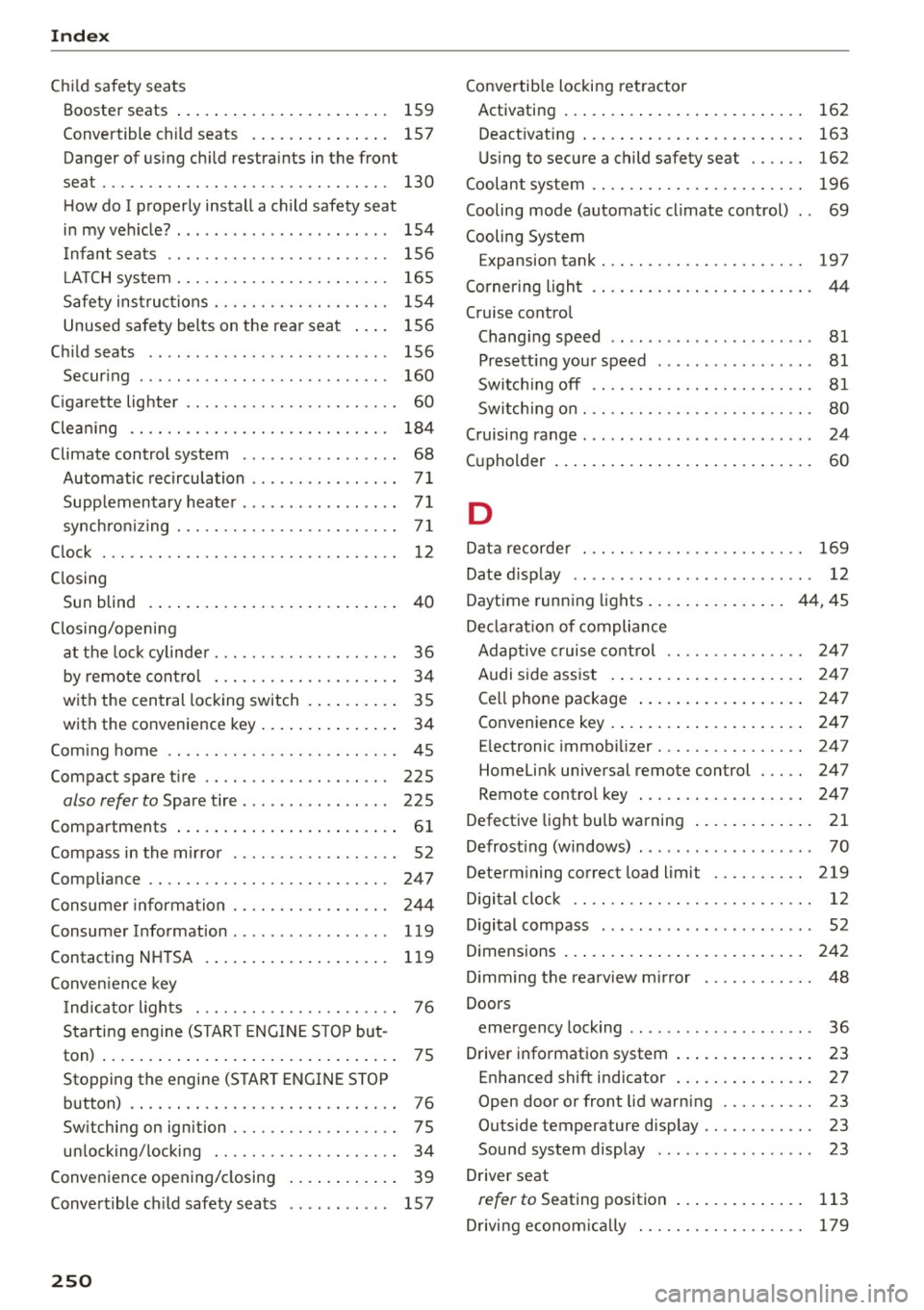
Index
Child safety sea ts
Booster seats . . . . . . . . . . . . . . . . . . . . . . . 159
Convertible c hild seats . . . . . . . . . . . . . . . 157
Danger of using ch ild restra ints in the front
sea t . . . . . . . . . . . . . . . . . . . . . . . . . . . . . . . 130
H ow do I proper ly install a child safety seat
i n my ve hicle? ... ... .. ... ..... .. .. .. . 154
I nfant seats . . . . . . . . . . . . . . . . . . . . . . . . 156
L A T CH sys tem . . . . . . . . . . . . . . . . . . . . . . . 165
S afety ins tructions . . . . . . . . . . . . . . . . . . . 154
Unused safety belts on the rear seat . . . . 156
Ch ild seats . . . . . . . . . . . . . . . . . . . . . . . . . . 156
Secur ing . . . . . . . . . . . . . . . . . . . . . . . . . . . 160
Cigarette lighter . . . . . . . . . . . . . . . . . . . . . . . 60
C le ani ng . . . . . . . . . . . . . . . . . . . . . . . . . . . . 184
Climate contro l system . . . . . . . . . . . . . . . . . 68
Automatic recirculation . . . . . . . . . . . . . . . . 7 1
Supp lementary heater . . . . . . . . . . . . . . . . . 7 1
synch ron izing . . . . . . . . . . . . . . . . . . . . . . . . 7 1
Clock . . . . . . . . . . . . . . . . . . . . . . . . . . . . . . . . 12
C losing
Sun blind . . . . . . . . . . . . . . . . . . . . . . . . . . . 40
C losing/openi ng
at the loc k cylinde r. . . . . . . . . . . . . . . . . . . . 36
by remote con tro l . . . . . . . . . . . . . . . . . . . . 34
with the cen tral locking switch . . . . . . . . . . 35
with the convenience key . . . . . . . . . . . . . . . 34
Com ing home . . . . . . . . . . . . . . . . . . . . . . . . . 45
Compact spare t ire . . . . . . . . . . . . . . . . . . . . 225
also refer to Spare tire . . . . . . . . . . . . . . . . 225
Compartments . . . . . . . . . . . . . . . . . . . . . . . . 61
Compass in the mir ro r . . . . . . . . . . . . . . . . . . 52
Comp liance . . . . . . . . . . . . . . . . . . . . . . . . . . 247
Consumer informa tion . . . . . . . . . . . . . . . . . 2 44
Consumer I nformat ion . . . . . . . . . . . . . . . . . 119
Contacting N HTSA
119
Conven ience key
I ndic ator l igh ts . . . . . . . . . . . . . . . . . . . . . . 76
S tarting engine (STAR T ENGINE S TO P bu t-
ton) . . . . . . . . . . . . . . . . . . . . . . . . . . . . . . . . 75
Stopping the engine (S TAR T ENGINE STOP
button) . . . . . . . . . . . . . . . . . . . . . . . . . . . . . 76
Sw itching on ignition . . . . . . . . . . . . . . . . . . 75
u nl ocking/locking . . . . . . . . . . . . . . . . . . . . 34
Conven ience opening/ closing . . . . . . . . . . . . 39
Convert ible ch ild safety s eats . . . . . . . . . . . 157
250
Convertib le locking retractor
Activating . . . . . . . . . . . . . . . . . . . . . . . . . . 162
Deact ivat ing . . . . . . . . . . . . . . . . . . . . . . . . 163
U sing t o secure a child safety seat . . . . . . 162
C oolant system . . . . . . . . . . . . . . . . . . . . . . . 196
Cooling mode (automat ic climate control) . . 69
Cooling System Expansion tank... .. ............... .. 197
Corner ing l igh t . . . . . . . . . . . . . . . . . . . . . . . . 44
Cruise contro l
Changi ng speed . . . . . . . . . . . . . . . . . . . . . . 81
P resett ing your speed . . . . . . . . . . . . . . . . . 81
Swit ching off . . . . . . . . . . . . . . . . . . . . . . . . 81
Swi tchin g on . . . . . . . . . . . . . . . . . . . . . . . . . 80
C ruisi ng range . . . . . . . . . . . . . . . . . . . . . . . . . 24
( up holder . . . . . . . . . . . . . . . . . . . . . . . . . . . . 60
D
Data recor der . . . . . . . . . . . . . . . . . . . . . . . . 169
Date disp lay . . . . . . . . . . . . . . . . . . . . . . . . . . 12
Daytime runn ing lig hts. . . . . . . . . . . . . . . 44 , 45
De clarat io n of compliance
Adap tive cruise control . . . . . . . . . . . . . . . 2 47
Audi s ide ass ist . . . . . . . . . . . . . . . . . . . . . 24 7
Ce ll phone package . . . . . . . . . . . . . . . . . . 247
Convenience key . . . . . . . . . . . . . . . . . . . . . 247
E lectronic immob ilizer. . . . . . . . . . . . . . . . 247
Homelink universal remote control . . . . . 247
Remote contro l key . . . . . . . . . . . . . . . . . . 247
Defect ive light bu lb wa rning . . . . . . . . . . . . . 21
Defrost ing (windows) . . . . . . . . . . . . . . . . . . . 70
Dete rm ining correct load limit .... .... .. 219
D igi tal cloc k . . . . . . . . . . . . . . . . . . . . . . . . . . 12
D igital compass . . . . . . . . . . . . . . . . . . . . . . . 52
Dimensions . . . . . . . . . . . . . . . . . . . . . . . . . . 242
D imm ing t he rearv iew m irror . . . . . . . . . . . . 48
Doors emergency lock ing . . . . . . . . . . . . . . . . . . . . 36
D river informat ion system . . . . . . . . . . . . . . . 23
En hanced shift indicator . . . . . . . . . . . . . . . 2 7
Open door or front lid warning . . . . . . . . . . 23
Outs ide tempe ratu re disp lay . . . . . . . . . . . . 23
Sound system display . . . . . . . . . . . . . . . . . 23
D river seat
refer to Seating position . . . . . . . . . . . . . . 113
D rivi ng econom ica lly . . . . . . . . . . . . . . . . . . 179